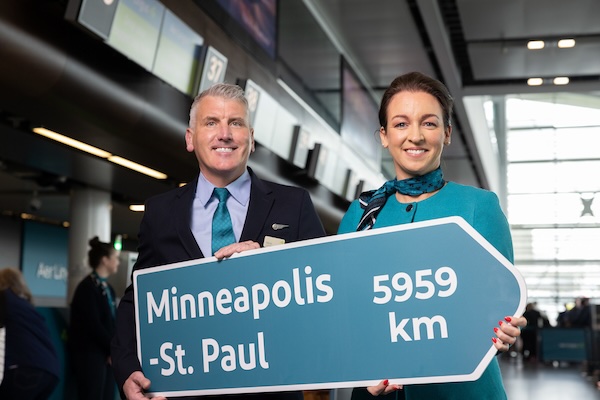Aer Lingus has successfully reinstated its full transatlantic network, marking a pivotal recovery from the pandemic hiatus. The return of the Dublin to Minneapolis-St Paul route highlights a strategic commitment to reviving international connectivity.
The airline’s decision to restore this route underscores not only the growing demand from passengers but also Aer Lingus’s dedication to maintaining robust transatlantic links. This restoration signifies a comprehensive response to both market needs and strategic airline objectives.
Revival of Transatlantic Connectivity
Aer Lingus has announced a significant step in its post-pandemic recovery by fully restoring its transatlantic network. This recovery includes the re-instatement of flights to Minneapolis-St Paul from Dublin, a vital connection that had been on hold since March 2020 due to the Covid-19 pandemic. The service, powered by Airbus A330 aircraft, operates four times a week. This move signals a return to pre-pandemic operations for the airline, reflecting both market demand and a strategic commitment to transatlantic routes.
Strategic Importance of the Route
The reintroduction of the Dublin to Minneapolis-St Paul route is more than a mere addition to Aer Lingus’s schedule. It represents a crucial business link between Ireland and the United States, facilitating corporate engagements and enhancing economic ties. The restoration is not just about passenger numbers; it underscores the strategic importance of maintaining robust international connectivity to key business hubs.
Commitment to Customer Demand
In response to a noticeable demand from passengers, Aer Lingus strategically resumed the route. Many customers expressed a desire for the return of this specific service due to its convenience in connecting to various US destinations. The restoration of this route aligns with the airline’s dedication to meeting passenger needs and enhancing customer experience through seamless transatlantic travel.
Aer Lingus’s commitment to re-establishing its North American network is further underscored by its competitive pricing strategy. Offering one-way fares starting at £279, the airline demonstrates a customer-centric approach that aims to make travel more accessible while encouraging increased bookings.
A Brief History and Future Aspirations
The Dublin to Minneapolis-St Paul route initially launched in July 2019, offering strategic and convenient connections for both leisure and business travellers. Despite its promising start, the service was curtailed less than a year later due to the pandemic impacts, marking a significant hiatus in the airline’s operations.
Looking ahead, Aer Lingus aims to not only solidify its existing routes but also to explore new opportunities for growth within the transatlantic market. By leveraging its Dublin hub, the airline aspires to expand its reach further into Europe and North America, enhancing its global network.
Aer Lingus’s Corporate Perspective
Chief Strategy and Planning Officer, Reid Moody, expressed enthusiasm over the network’s restoration. He stated, “Aer Lingus is delighted to welcome the return of Minneapolis-St Paul to our North American route network.” His statement highlights the airline’s strategic efforts to rejuvenate its operations and maintain competitive edge.
Moody further emphasised the importance of this route in fostering economic connections between Europe and North America. By reinstating this link, Aer Lingus is committed to supporting business travel and promoting connectivity at an international level.
Operational Challenges and Achievements
The restoration of the full transatlantic network did not come without challenges. Aer Lingus had to navigate various operational and logistical hurdles post-pandemic. However, the successful resumption of services is a testament to the airline’s resilience and strategic planning. The airline’s ability to overcome these challenges demonstrates its strength and commitment to service excellence.
The airline’s strategy involved thorough market analysis and a phased approach to reintroducing routes, ensuring that the demand and support infrastructure were adequately aligned.
The Broader Impact on the Aviation Industry
Aer Lingus’s move to restore its transatlantic network highlights a positive trend in the aviation industry’s recovery from the pandemic. As airlines regain momentum, the emphasis on restoring international routes signifies both resilience and optimism for future growth. This trend serves as a broader indicator of the industry’s gradual return to stability and expansion.
The aviation sector, while recuperating, remains vigilant about potential future disruptions, adapting strategies that incorporate flexibility and risk management as key components.
Conclusion
The full restoration of Aer Lingus’s pre-pandemic transatlantic network marks a significant milestone in its operational recovery. Through strategic foresight and commitment to customer needs, the airline reaffirms its role as a vital connector between North America and Europe. This achievement reflects both market resilience and Aer Lingus’s dedication to enhancing international travel experiences.
Aer Lingus’s full transatlantic revival represents a promising advancement for international air travel. The airline’s strategic efforts have successfully re-established crucial connectivity, supporting both passenger needs and economic links. This milestone highlights Aer Lingus’s crucial role in the aviation sector’s recovery.

